�
27th February 2011 - New research
THE WORST NON-MOTOR SYMPTOMS IN PARKINSON'S DISEASE
Movement Disorders [2010]
25 (15) : 2493-2500 (Gallagher DA, Lees AJ, Schrag A.)�
Complete abstract
Although muscular movement is the most characteristic symptom of
Parkinson's Disease, non-motor symptoms (those that do not concern muscular
movement) are increasingly recognised as neglected aspects of Parkinson's
Disease. The most common non-motor symptom has been found to be urinary. In
order of frequency the most common symptoms are : autonomic dysfunction,
particularly urinary and gastrointestinal
 symptoms
(84%), mood (74%), fatigue (74%),� daytime somnolence (65%), pain (56%),
nocturnal sleep problems (55%), and psychosis (55%). Motor fluctuations
(57%) and dyskinesia (43%) were associated with worse quality of life.
Depression had the strongest association with a lower health related quality of
life, then fatigue, thermoregulatory, gastrointestinal, cardiovascular autonomic
function, daytime somnolence, and urinary problems. Whilst psychiatric problems
are increasingly documented, many symptoms, particularly those perceived as embarrassing or unrelated, remain under reported. In order to refer to this article on its
own
click here.
symptoms
(84%), mood (74%), fatigue (74%),� daytime somnolence (65%), pain (56%),
nocturnal sleep problems (55%), and psychosis (55%). Motor fluctuations
(57%) and dyskinesia (43%) were associated with worse quality of life.
Depression had the strongest association with a lower health related quality of
life, then fatigue, thermoregulatory, gastrointestinal, cardiovascular autonomic
function, daytime somnolence, and urinary problems. Whilst psychiatric problems
are increasingly documented, many symptoms, particularly those perceived as embarrassing or unrelated, remain under reported. In order to refer to this article on its
own
click here.
�
�������������������������������������������������������������������������������������������������������������������������������������������������
� 23rd
February 2011 - New book
MEDIFOCUS GUIDEBOOK ON : PARKINSON'S DISEASE
Medifocus.com (Author), Elliot Jacob (Editor)
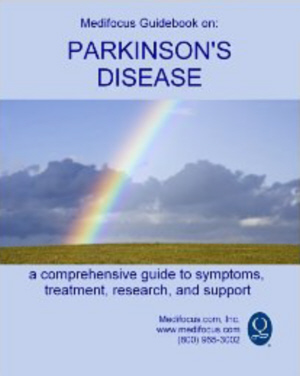 Publisher's
description : You will get answers to your questions, including risk factors of
Parkinson's Disease, standard and alternative treatment options, leading
doctors, hospitals and medical centers that specialize in Parkinson's Disease,
results of the latest clinical trials, support groups and additional resources,
and promising new treatments on the horizon. This one of a kind Guidebook offers
answers to your critical health questions including the latest treatments,
clinical trials, and professional level information you can trust and understand
culled from the latest peer-reviewed journals; and a unique resource to find
leading experts, institutions, and support organizations including contact
information and hyperlinks.
Click here for more details.
For
more books concerning Parkinson's Disease go to
Parkinson's Disease Books.
Publisher's
description : You will get answers to your questions, including risk factors of
Parkinson's Disease, standard and alternative treatment options, leading
doctors, hospitals and medical centers that specialize in Parkinson's Disease,
results of the latest clinical trials, support groups and additional resources,
and promising new treatments on the horizon. This one of a kind Guidebook offers
answers to your critical health questions including the latest treatments,
clinical trials, and professional level information you can trust and understand
culled from the latest peer-reviewed journals; and a unique resource to find
leading experts, institutions, and support organizations including contact
information and hyperlinks.
Click here for more details.
For
more books concerning Parkinson's Disease go to
Parkinson's Disease Books.
�
21st February 2011 - New research
ROTIGOTINE
(NEUPRO) CLINICAL TRIAL RESULTS
Movement Disorders [2011]
26 (1) : 90-99 (Trenkwalder C, Kies B, Rudzinska M, Fine J, Nikl J, Honczarenko
K, Dioszeghy P, Hill D, Anderson T, Myllyla V, Kassubek J, Steiger M, Zucconi M,
Tolosa E, Poewe W, Surmann E, Whitesides J, Boroojerdi B, Chaudhuri KR)
Complete abstract
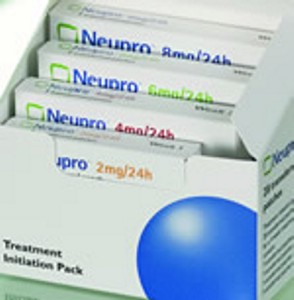 People
with Parkinson's
Disease who had unsatisfactory early-morning motor symptom control were given
either rotigotine (2mg-16mg rotigotine every 24 hours) or a placebo.
Neupro� (Rotigotine Transdermal System) is a
dopamine agonist that is applied to the skin in order to continuously deliver
rotigotine over a 24-hour period.
For more information go to
Neupro.
Movement� symptoms improved in comparison
to the use of a placebo, but not greatly as was claimed.
Sleep improved in comparison to a
placebo. The most
frequently reported adverse events were nausea (rotigotine 21% v 9% placebo),
application site reactions (rotigotine 15% v 4% placebo), and dizziness
(rotigotine 10% v 6% placebo).�
People
with Parkinson's
Disease who had unsatisfactory early-morning motor symptom control were given
either rotigotine (2mg-16mg rotigotine every 24 hours) or a placebo.
Neupro� (Rotigotine Transdermal System) is a
dopamine agonist that is applied to the skin in order to continuously deliver
rotigotine over a 24-hour period.
For more information go to
Neupro.
Movement� symptoms improved in comparison
to the use of a placebo, but not greatly as was claimed.
Sleep improved in comparison to a
placebo. The most
frequently reported adverse events were nausea (rotigotine 21% v 9% placebo),
application site reactions (rotigotine 15% v 4% placebo), and dizziness
(rotigotine 10% v 6% placebo).�
In April 2008, Neupro was withdrawn from use in the
U.S.A. because specific batches of Neupro had deviated from their specification.
In June 2009, UCB proposed new refrigerated storage conditions to alleviate
crystallization on the patches. UCB has already made progress in reformulation
and remains committed to bringing Neupro to U.S. patients. For more
information go to the
News release. In order to refer to this article on its
own
click here.
�
18th February 2011 - New research
THE RISK OF COMPULSIONS IN PARKINSON'S DISEASE
Parkinsonism Related
Disorders [2011] Feb 8 [Epub ahead of print] (Hassan A, Bower JH, Kumar N,
Matsumoto JY, Fealey RD, Josephs KA, Ahlskog JE)�
Complete abstract
Dopamine agonist treatment of Parkinson's Disease carries a greatly increased
risk of compulsive behaviour. Compulsive behaviour provoked by dopamine agonists
often goes undetected in clinical series, especially if they are not
specifically enquired about. Of those people with Parkinson's Disease taking
dopamine agonists 22% experienced compulsive behaviour, and 16% were pathologic.
However, when the analysis was restricted to patients taking dopamine agonist
doses that were at least minimally therapeutic, pathological behaviours were
documented in 24% of people. The most common form of compulsions caused by
dopamine agonists are : gambling (36%), hypersexuality (35%), compulsive
spending or shopping (26%), binge eating (17%), compulsive hobbying (12%) and
compulsive computer use (9%). The vast majority of affected cases (94%) were
concurrently taking Sinemet or the equivalent. Among those with adequate follow
up, compulsive behaviours completely or partly resolved when the dopamine
agonist dose was reduced or ceased. In order to refer to this article on its own
click here.
 ���
���
 ���
���
 ����
����
 ���
���
 ���
���

������������������������������������������������������������������������������������������������������������������������������������������������
15th February 2011 - New research
PRELADENANT
CLINICAL TRIAL RESULTS
The Lancet Neurology,
Early Online Publication, 10 February 2011 (Robert A Hauser, Marc Cantillon,
Emmanuelle Pourcher, Federico Micheli, Vincent Mok, Marco Onofrj, Susan Huyck,
Kenneth Wolski)�
Complete abstract
Preladenant is an adenosine 2A (A2A) receptor antagonist. Researchers aimed to
assess the efficacy and safety of Preladenant in patients with Parkinson's
disease and motor fluctuations who were receiving L-dopa and other Parkinson's
Disease drugs. Patients were assigned to receive 1mg, 2mg, 5mg, or 10 mg oral Preladenant twice daily,
or matching placebo for 12 weeks. There was no significant change as a result of
taking 1mg or 2mg of Preladenant.
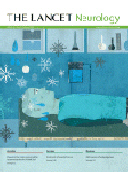 Average
daily off time was reduced by 60 minutes using 5mg Preladenant. Average daily
off time was reduced by 72
minutes using 10mg Preladenant. The most common adverse events for were
worsening of Parkinson's Disease, somnolence,
dyskinesia, nausea, constipation, and insomnia. However, the frequency of these
adverse events was little different from those people taking the placebo. So it
is doubtful whether they are of significance. The authors consequently believe
that 5mg Preladenant and 10 mg Preladenant twice daily might be clinically
useful to reduce off time in patients with Parkinson's disease and motor
fluctuations. For more information go to the
News release. In order to refer to this
article on its own
click here.
Average
daily off time was reduced by 60 minutes using 5mg Preladenant. Average daily
off time was reduced by 72
minutes using 10mg Preladenant. The most common adverse events for were
worsening of Parkinson's Disease, somnolence,
dyskinesia, nausea, constipation, and insomnia. However, the frequency of these
adverse events was little different from those people taking the placebo. So it
is doubtful whether they are of significance. The authors consequently believe
that 5mg Preladenant and 10 mg Preladenant twice daily might be clinically
useful to reduce off time in patients with Parkinson's disease and motor
fluctuations. For more information go to the
News release. In order to refer to this
article on its own
click here.
�
12th February 2011 - New product
DISTINGUISHING PARKINSON'S DISEASE USING THE
EYES
EyeBrain has announced that its eye-tracking
system, Mobile Eye Brain Tracker (EBT), is available for the detection of
Parkinson-plus diseases. Parkinson-plus syndromes have additional features that
distinguish them from Parkinson's Disease.
Different areas of the brain are
involved in producing eye movements, and abnormalities that occur can be linked
to dysfunction in certain areas of the
brain. Results have shown that eye movements provide a more accurate early
diagnosis than traditional clinical examinations.� The Mobile EBT is
non-invasive and costs less than regularly used imaging techniques, such as MRI or x-rays.�
For more information go to
Eye Brain Tracker.
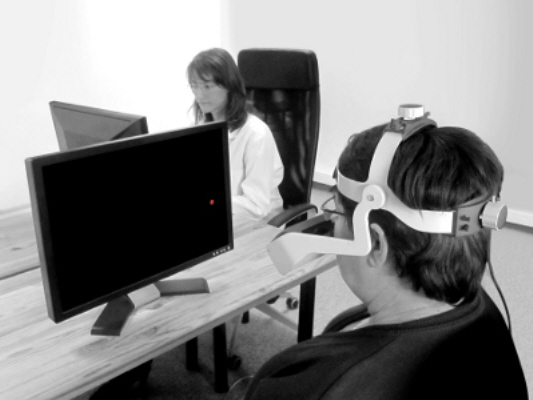 The
equipment
consists of : a recording device for high-frequency, accurate eye movement
measurement, two screens, an introductory computer application for
behavioural testing, and an automatic test analysis application. When an eye
movement exam is conducted, the tests are displayed on a screen. The subject
receives instructions on how to take the tests. The subject's eye movements are
recorded while he takes the test. Once the tests are completed, the examiner may
conduct a thoroughly automatic analysis, with the option of manually adjusting
the results to enhance quality. Based on this analysis, an eye movement report
is automatically printed to aid the examiner in diagnosing patients' possible
illnesses.
In order to refer to this
article on its own
click here.
The
equipment
consists of : a recording device for high-frequency, accurate eye movement
measurement, two screens, an introductory computer application for
behavioural testing, and an automatic test analysis application. When an eye
movement exam is conducted, the tests are displayed on a screen. The subject
receives instructions on how to take the tests. The subject's eye movements are
recorded while he takes the test. Once the tests are completed, the examiner may
conduct a thoroughly automatic analysis, with the option of manually adjusting
the results to enhance quality. Based on this analysis, an eye movement report
is automatically printed to aid the examiner in diagnosing patients' possible
illnesses.
In order to refer to this
article on its own
click here.
���������������������
������������������������������������������������������������������������������������������������������������������������������������������������������ 9th February 2011 - New research
INTRANASAL STEM CELLS FOR� PARKINSON'S
DISEASE
Rejuvenation Research
[2011] February [ahead of print]
(Lusine
Danielyan, Richard Sch�fer, Andreas von Ameln-Mayerhofer, Felix Bernhard,
Stephan Verleysdonk, Marine Buadze, Ali Lourhmati, Tim Klopfer, Felix Schaumann,
Barbara Schmid, Christoph Koehle, Barbara Proksch, Robert Weissert, Holger M.
Reichardt, Jens van den Brandt, Gayane H. Buniatian, Matthias Schwab, Christoph
H. Gleiter, William H. Frey)
Complete study
Stem cells have been delivered intranasally (via
the nose), as a means of trying to treat Parkinson's Disease. Intranasal
administration of stem cells to the brain is a proposed alternative to the
current surgical procedures, which place stem cells directly in to the brain.
Instead of one surgical operation, the ease of intranasal administration opens
up the possibility of chronic stem cell treatment, which would increase the
number of cells
 delivered
to the brain. Many of
the stem cells delivered intranasally survived for at least six
months in the brain. The stem cells rapidly migrated to the damaged areas. It is
claimed that the method substantially improved motor function in Parkinson's
Disease. However, the study was only carried out on rats that did not actually
have Parkinson's Disease. For years it had been claimed that stem cell therapy
would be able to rid Parkinson's Disease. However, despite stem cell operations
now having been carried out around the world, nobody has ever been rid of Parkinson's
Disease using stem cell therapy.
In order to refer to this
article on its own
click here.
delivered
to the brain. Many of
the stem cells delivered intranasally survived for at least six
months in the brain. The stem cells rapidly migrated to the damaged areas. It is
claimed that the method substantially improved motor function in Parkinson's
Disease. However, the study was only carried out on rats that did not actually
have Parkinson's Disease. For years it had been claimed that stem cell therapy
would be able to rid Parkinson's Disease. However, despite stem cell operations
now having been carried out around the world, nobody has ever been rid of Parkinson's
Disease using stem cell therapy.
In order to refer to this
article on its own
click here.
�
7th
February 2011 - New book
HOW DOES THE DRILL KNOW WHEN TO STOP : LIVING
GRACEFULLY THROUGH PARKINSON'S DISEASE
Perry Conrad
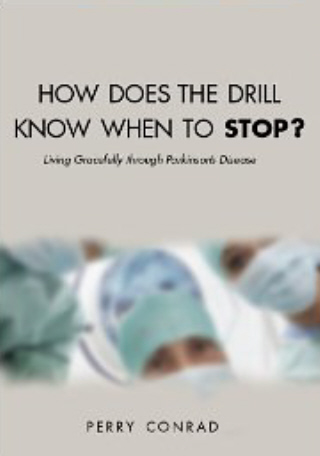 Publisher's
description : At forty-one-years-old, Perry Conrad experienced a tremor in his
left foot. Conrad consulted a neurologist who confirmed his suspicion: he had
Parkinson's disease. In How Does the Drill Know When to Stop?, Conrad shares the
insight that allowed him to accept and eventually overcome the limitations of
Parkinson's disease and discusses the surgery he underwent seven years later
that nearly eliminated his symptoms. If the cross you bear has brought you to
your knees, or if you've ever considered your response to the unknown adversity
that awaits us all, ask yourself, How Does the Drill Know When to Stop? and
discover how past experience can help guide you through the hardship
you may face tomorrow.�
Click here for more details.
For
more books concerning Parkinson's Disease go to
Parkinson's Disease Books.
Publisher's
description : At forty-one-years-old, Perry Conrad experienced a tremor in his
left foot. Conrad consulted a neurologist who confirmed his suspicion: he had
Parkinson's disease. In How Does the Drill Know When to Stop?, Conrad shares the
insight that allowed him to accept and eventually overcome the limitations of
Parkinson's disease and discusses the surgery he underwent seven years later
that nearly eliminated his symptoms. If the cross you bear has brought you to
your knees, or if you've ever considered your response to the unknown adversity
that awaits us all, ask yourself, How Does the Drill Know When to Stop? and
discover how past experience can help guide you through the hardship
you may face tomorrow.�
Click here for more details.
For
more books concerning Parkinson's Disease go to
Parkinson's Disease Books.
�
��
.gif)
.gif)
 symptoms
(84%), mood (74%), fatigue (74%),� daytime somnolence (65%), pain (56%),
nocturnal sleep problems (55%), and psychosis (55%). Motor fluctuations
(57%) and dyskinesia (43%) were associated with worse quality of life.
Depression had the strongest association with a lower health related quality of
life, then fatigue, thermoregulatory, gastrointestinal, cardiovascular autonomic
function, daytime somnolence, and urinary problems. Whilst psychiatric problems
are increasingly documented, many symptoms, particularly those perceived as embarrassing or unrelated, remain under reported. In order to refer to this article on its
own
symptoms
(84%), mood (74%), fatigue (74%),� daytime somnolence (65%), pain (56%),
nocturnal sleep problems (55%), and psychosis (55%). Motor fluctuations
(57%) and dyskinesia (43%) were associated with worse quality of life.
Depression had the strongest association with a lower health related quality of
life, then fatigue, thermoregulatory, gastrointestinal, cardiovascular autonomic
function, daytime somnolence, and urinary problems. Whilst psychiatric problems
are increasingly documented, many symptoms, particularly those perceived as embarrassing or unrelated, remain under reported. In order to refer to this article on its
own  Publisher's
description : You will get answers to your questions, including risk factors of
Parkinson's Disease, standard and alternative treatment options, leading
doctors, hospitals and medical centers that specialize in Parkinson's Disease,
results of the latest clinical trials, support groups and additional resources,
and promising new treatments on the horizon. This one of a kind Guidebook offers
answers to your critical health questions including the latest treatments,
clinical trials, and professional level information you can trust and understand
culled from the latest peer-reviewed journals; and a unique resource to find
leading experts, institutions, and support organizations including contact
information and hyperlinks.
Publisher's
description : You will get answers to your questions, including risk factors of
Parkinson's Disease, standard and alternative treatment options, leading
doctors, hospitals and medical centers that specialize in Parkinson's Disease,
results of the latest clinical trials, support groups and additional resources,
and promising new treatments on the horizon. This one of a kind Guidebook offers
answers to your critical health questions including the latest treatments,
clinical trials, and professional level information you can trust and understand
culled from the latest peer-reviewed journals; and a unique resource to find
leading experts, institutions, and support organizations including contact
information and hyperlinks.
 People
with Parkinson's
Disease who had unsatisfactory early-morning motor symptom control were given
either rotigotine (2mg-16mg rotigotine every 24 hours) or a placebo.
Neupro� (Rotigotine Transdermal System) is a
dopamine agonist that is applied to the skin in order to continuously deliver
rotigotine over a 24-hour period.
For more information go to
People
with Parkinson's
Disease who had unsatisfactory early-morning motor symptom control were given
either rotigotine (2mg-16mg rotigotine every 24 hours) or a placebo.
Neupro� (Rotigotine Transdermal System) is a
dopamine agonist that is applied to the skin in order to continuously deliver
rotigotine over a 24-hour period.
For more information go to
 ���
���
 ���
���
 ����
����
 ���
���
 ���
���

 Average
daily off time was reduced by 60 minutes using 5mg Preladenant. Average daily
off time was reduced by 72
minutes using 10mg Preladenant. The most common adverse events for were
worsening of Parkinson's Disease, somnolence,
dyskinesia, nausea, constipation, and insomnia. However, the frequency of these
adverse events was little different from those people taking the placebo. So it
is doubtful whether they are of significance. The authors consequently believe
that 5mg Preladenant and 10 mg Preladenant twice daily might be clinically
useful to reduce off time in patients with Parkinson's disease and motor
fluctuations. For more information go to the
Average
daily off time was reduced by 60 minutes using 5mg Preladenant. Average daily
off time was reduced by 72
minutes using 10mg Preladenant. The most common adverse events for were
worsening of Parkinson's Disease, somnolence,
dyskinesia, nausea, constipation, and insomnia. However, the frequency of these
adverse events was little different from those people taking the placebo. So it
is doubtful whether they are of significance. The authors consequently believe
that 5mg Preladenant and 10 mg Preladenant twice daily might be clinically
useful to reduce off time in patients with Parkinson's disease and motor
fluctuations. For more information go to the
 The
equipment
consists of : a recording device for high-frequency, accurate eye movement
measurement, two screens, an introductory computer application for
behavioural testing, and an automatic test analysis application. When an eye
movement exam is conducted, the tests are displayed on a screen. The subject
receives instructions on how to take the tests. The subject's eye movements are
recorded while he takes the test. Once the tests are completed, the examiner may
conduct a thoroughly automatic analysis, with the option of manually adjusting
the results to enhance quality. Based on this analysis, an eye movement report
is automatically printed to aid the examiner in diagnosing patients' possible
illnesses.
In order to refer to this
article on its own
The
equipment
consists of : a recording device for high-frequency, accurate eye movement
measurement, two screens, an introductory computer application for
behavioural testing, and an automatic test analysis application. When an eye
movement exam is conducted, the tests are displayed on a screen. The subject
receives instructions on how to take the tests. The subject's eye movements are
recorded while he takes the test. Once the tests are completed, the examiner may
conduct a thoroughly automatic analysis, with the option of manually adjusting
the results to enhance quality. Based on this analysis, an eye movement report
is automatically printed to aid the examiner in diagnosing patients' possible
illnesses.
In order to refer to this
article on its own
 delivered
to the brain. Many of
the stem cells delivered intranasally survived for at least six
months in the brain. The stem cells rapidly migrated to the damaged areas. It is
claimed that the method substantially improved motor function in Parkinson's
Disease. However, the study was only carried out on rats that did not actually
have Parkinson's Disease. For years it had been claimed that stem cell therapy
would be able to rid Parkinson's Disease. However, despite stem cell operations
now having been carried out around the world, nobody has ever been rid of Parkinson's
Disease using stem cell therapy.
In order to refer to this
article on its own
delivered
to the brain. Many of
the stem cells delivered intranasally survived for at least six
months in the brain. The stem cells rapidly migrated to the damaged areas. It is
claimed that the method substantially improved motor function in Parkinson's
Disease. However, the study was only carried out on rats that did not actually
have Parkinson's Disease. For years it had been claimed that stem cell therapy
would be able to rid Parkinson's Disease. However, despite stem cell operations
now having been carried out around the world, nobody has ever been rid of Parkinson's
Disease using stem cell therapy.
In order to refer to this
article on its own
 Publisher's
description : At forty-one-years-old, Perry Conrad experienced a tremor in his
left foot. Conrad consulted a neurologist who confirmed his suspicion: he had
Parkinson's disease. In How Does the Drill Know When to Stop?, Conrad shares the
insight that allowed him to accept and eventually overcome the limitations of
Parkinson's disease and discusses the surgery he underwent seven years later
that nearly eliminated his symptoms. If the cross you bear has brought you to
your knees, or if you've ever considered your response to the unknown adversity
that awaits us all, ask yourself, How Does the Drill Know When to Stop? and
discover how past experience can help guide you through the hardship
you may face tomorrow.�
Publisher's
description : At forty-one-years-old, Perry Conrad experienced a tremor in his
left foot. Conrad consulted a neurologist who confirmed his suspicion: he had
Parkinson's disease. In How Does the Drill Know When to Stop?, Conrad shares the
insight that allowed him to accept and eventually overcome the limitations of
Parkinson's disease and discusses the surgery he underwent seven years later
that nearly eliminated his symptoms. If the cross you bear has brought you to
your knees, or if you've ever considered your response to the unknown adversity
that awaits us all, ask yourself, How Does the Drill Know When to Stop? and
discover how past experience can help guide you through the hardship
you may face tomorrow.�